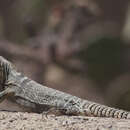en
names in breadcrumbs


Ctenosaura is a lizard genus commonly known as spinytail iguanas or ctenosaurs. The genus is part of the large lizard family, Iguanidae and is native to Mexico and Central America. The name is derived from two Greek words: ctenos (κτενός), meaning "comb" (referring to the comblike spines on the lizard's back and tail), and saura (σαύρα), meaning "lizard".
The species range in size (total length, including the tail) from about 12.5 centimetres (4.9 in) to well over 1 metre (39 in). The distinctive feature of this genus is the presence of enlarged, spiny scales on the tail.
Diet: Ctenosaurs are generally omnivorous, feeding on fruits, flowers, foliage, and small animals.
While studying physiological correlates of locomotion in lizards, a "burst speed" of 34.6 km/h (21.5 miles/h) was recorded by a black spiny-tail iguana (Ctenosaura similis), which is the highest speed reported for a lizard.[1]: p.812 [2]
C. pectinata, C. similis, and C. quinquecarinata are popular as pets.
At least two species, Ctenosaura pectinata and Ctenosaura similis, have been introduced into southern areas of Texas and Florida. They are also now in southern Arizona.
The genus Ctenosaura represents the most diverse group of iguanas with 15 currently recognized species and at least two unrecognized species.[3][4] These species inhabit lowland dry forests, below 1,200 metres (3,900 ft) elevation, on both coasts of Mexico and Central America.[3] All species of Ctenosaura fall within one of seven clades.[3] Distributions of these clades fall geographically within well established areas.[3] Closely related species show allopatry whereas species from divergent clades show sympatry.[3]
Image Species Common name Authority Geographic range Ctenosaura acanthura Mexican spiny-tailed iguana[5] (Shaw, 1802)[6] Eastern Mexico
Ctenosaura acanthura Mexican spiny-tailed iguana[5] (Shaw, 1802)[6] Eastern Mexico  Ctenosaura bakeri Baker's spinytail iguana Stejneger, 1901[7] Utila island off Honduras Ctenosaura clarki Michoacan club tail [5] Bailey, 1928[8] Western Mexico Ctenosaura conspicuosa Isla San Esteban spiny-tailed iguana [5] Dickerson, 1919[9] San Esteban Island, Gulf of California Ctenosaura flavidorsalis yellowback spinytail iguana G. Köhler & Klemmer, 1994 Honduras, El Salvador, and Guatemala
Ctenosaura bakeri Baker's spinytail iguana Stejneger, 1901[7] Utila island off Honduras Ctenosaura clarki Michoacan club tail [5] Bailey, 1928[8] Western Mexico Ctenosaura conspicuosa Isla San Esteban spiny-tailed iguana [5] Dickerson, 1919[9] San Esteban Island, Gulf of California Ctenosaura flavidorsalis yellowback spinytail iguana G. Köhler & Klemmer, 1994 Honduras, El Salvador, and Guatemala  Ctenosaura hemilopha cape spiny-tail iguana [5] (Cope, 1863)[10] Southern half of Baja California, Mexico
Ctenosaura hemilopha cape spiny-tail iguana [5] (Cope, 1863)[10] Southern half of Baja California, Mexico  Ctenosaura macrolopha Sonora spiny-tailed iguana [5] Smith, H. M. 1972[11] Sonora, Mexico
Ctenosaura macrolopha Sonora spiny-tailed iguana [5] Smith, H. M. 1972[11] Sonora, Mexico  Ctenosaura melanosterna black-chested spinytail iguana Buckley & Axtell, 1997 Honduras Ctenosaura nolascensis Isla San Pedro Nolasco spiny-tailed iguana [5] Smith, H. M. 1972[11] San Pedro Nolasco Island, Gulf of California
Ctenosaura melanosterna black-chested spinytail iguana Buckley & Axtell, 1997 Honduras Ctenosaura nolascensis Isla San Pedro Nolasco spiny-tailed iguana [5] Smith, H. M. 1972[11] San Pedro Nolasco Island, Gulf of California  Ctenosaura oaxacana Oaxacan spiny-tail iguana [5] G. Köhler & Hasbún, 2001[12] Oaxaca, Mexico
Ctenosaura oaxacana Oaxacan spiny-tail iguana [5] G. Köhler & Hasbún, 2001[12] Oaxaca, Mexico  Ctenosaura oedirhina Roatán spinytail iguana de Queiroz, 1987 Roatán, Honduras
Ctenosaura oedirhina Roatán spinytail iguana de Queiroz, 1987 Roatán, Honduras  Ctenosaura palearis Guatemalan spinytail iguana Stejneger, 1899 Guatemala
Ctenosaura palearis Guatemalan spinytail iguana Stejneger, 1899 Guatemala  Ctenosaura pectinata western spiny-tail iguana [5] (Wiegmann, 1834)[13] Western Mexico. Introduced to southern areas of Texas and Florida.
Ctenosaura pectinata western spiny-tail iguana [5] (Wiegmann, 1834)[13] Western Mexico. Introduced to southern areas of Texas and Florida.  Ctenosaura quinquecarinata club tail iguana Gray, 1842[14] Nicaragua and Costa Rica.
Ctenosaura quinquecarinata club tail iguana Gray, 1842[14] Nicaragua and Costa Rica.  Ctenosaura similis black spiny-tail iguana [5] (Gray, 1831)[15] Mexico and Central America; reported in some Colombian islands, introduced to southern Florida.
Ctenosaura similis black spiny-tail iguana [5] (Gray, 1831)[15] Mexico and Central America; reported in some Colombian islands, introduced to southern Florida.  Ctenosaura similis, Costa Rica
Ctenosaura similis, Costa Rica Ctenosaura is a lizard genus commonly known as spinytail iguanas or ctenosaurs. The genus is part of the large lizard family, Iguanidae and is native to Mexico and Central America. The name is derived from two Greek words: ctenos (κτενός), meaning "comb" (referring to the comblike spines on the lizard's back and tail), and saura (σαύρα), meaning "lizard".